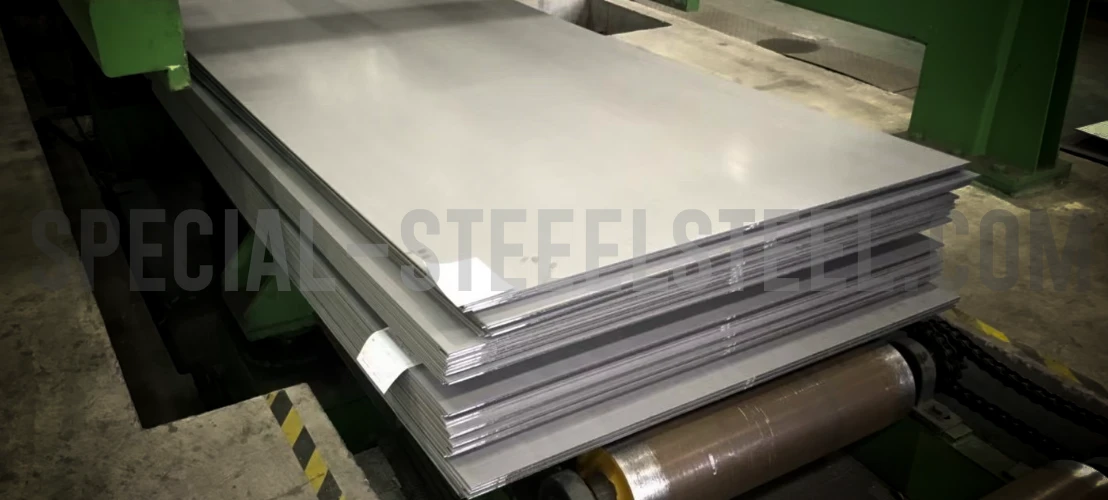1.4882, X50CrMnNiNbN21-9
X50CrMnNiNbN21-9, also designated as 1.4882, is a high-strength, nitrogen-strengthened austenitic stainless steel developed primarily for use in steam turbine blades and other high-temperature mechanical components. It combines good oxidation resistance, high creep rupture strength, and excellent fatigue performance with superior machinability and weldability. This material belongs to the group of heat-resistant austenitic steels stabilized with niobium and alloyed with nitrogen to enhance its mechanical endurance at elevated temperatures.

What is 1.4882, X50CrMnNiNbN21-9?
X50CrMnNiNbN21-9 (1.4882) is a robust austenitic stainless steel tailored for high-temperature applications requiring excellent mechanical strength, creep resistance, and oxidation stability. Its well-balanced chemical composition and favorable fabrication characteristics make it a preferred choice for components like turbine blades and engine valves.Applications
- Steam and gas turbine blades
- Valves for internal combustion engines
- High-temperature fasteners and components
- Heat exchangers and reactor parts
- Industrial furnaces and boiler internals
International Material Equivalents
| Country/Region | Equivalent/Similar Grade | Standard | Remarks |
|---|---|---|---|
| Germany | X50CrMnNiNbN21-9 | DIN EN 10088 / DIN 17243 | Official designation |
| USA | A286 (UNS S66286) | ASTM A453, A638 | Closest equivalent in high-temp austenitic steels |
| Russia | ЭП718 (EP718) | GOST 5632 | High-strength, creep-resistant austenitic steel |
| France | Z6CND21-09N | AFNOR NF A 35-572 | Similar chemistry and applications |
| UK | BS 3076 NA16 | BS EN 10095 | Work-hardening austenitic grade |
| Japan | SUS XM15J1 or SUS660 | JIS G4303 | Comparable creep resistance |
Chemical Composition (%)
| Element | Min (%) | Max (%) |
|---|---|---|
| C | 0.45 | 0.55 |
| Si | — | 0.45 |
| Mn | 8.00 | 10.00 |
| P | — | 0.045 |
| S | — | 0.030 |
| Cr | 20.00 | 22.00 |
| Ni | 3.50 | 5.50 |
| N | 0.40 | 0.60 |
| W | 0.80 | 1.50 |
| Nb+Ta | 1.80 | 2.50 |
| Element | 1.4882 | A286 (S66286) | ЭП718 | XM15J1 |
|---|---|---|---|---|
| C | ≤0.10 | ≤0.08 | ≤0.10 | ≤0.10 |
| Mn | 5.0–7.0 | ≤1.0 | ≤1.0 | 5.0–8.0 |
| Cr | 20.0–22.5 | 13.5–16.0 | 19–22 | 20–23 |
| Ni | 8.5–10.5 | 24–27 | 18–25 | 8–10 |
| Nb | 0.5–1.5 | 0.5–1.5 | 0.3–1.0 | 0.5–1.0 |
| N | 0.15–0.30 | — | ~0.1 | 0.15–0.3 |
| Si | ≤0.5 | ≤1.0 | ≤0.8 | ≤0.8 |
| S, P | ≤0.025 | ≤0.03 | ≤0.03 | ≤0.03 |
Material Properties
| Condition | Tensile Strength (MPa) | Yield Strength (MPa) | Elongation (%) | Hardness (HBW) |
|---|---|---|---|---|
| Controlled Cooling | ≈1300 | — | — | ≈385 |
| Quenched (1000–1100°C) | ≤1300 | — | — | ≤385 |
| +AT +P (d ≤ 40mm) | 950–1150 | ≥580 | ≥12 | HRC ≥30 |
Note: +AT = Solution Annealed, +P = Precipitation Hardened
| Property | +A (Annealed) | +QT (Quenched & Tempered) | +HT (Solution + Aging) |
|---|---|---|---|
| Yield Strength (Rp0.2), MPa | ≥350 | ≥620 | ≥750 |
| Tensile Strength, MPa | ≥750 | 850–1100 | ≥1000 |
| Elongation A5, % | ≥35 | ≥20 | ≥15 |
| Impact Toughness, J (20 °C) | ≥100 | ≥60 | ≥50 |
| Hardness (HB) | ≤260 | 280–320 | 300–340 |
High-Temperature Mechanical Properties
| Temperature (°C) | Tensile Strength (MPa) | 0.2% Proof Strength (MPa) |
|---|---|---|
| 500 | 680 | 350 |
| 550 | 650 | 330 |
| 600 | 610 | 310 |
| 650 | 550 | 285 |
| 700 | 480 | 260 |
| 750 | 410 | 240 |
| 800 | 340 | 220 |
Creep Strength
| Temperature (°C) | Creep Strength after 1000h (MPa) |
|---|---|
| 500 | 220 |
| 650 | 120 |
| 725 | 55 |
Physical Properties
| Property | Value |
|---|---|
| Density (g/cm³) | 7.8 |
| Elastic Modulus (GPa) | 205 |
| Thermal Expansion (10⁻⁶/K) | 15.5–18.8 (20–700°C) |
| Thermal Conductivity (W/m·K) | 14.5 |
| Specific Heat Capacity (J/kg·K) | 500 |
| Magnetic Properties | Non-magnetic |
Note: Austenitic steels may exhibit slight magnetism after aging or cold working.
Heat Treatment
| Process | Temperature (°C) | Cooling Medium |
|---|---|---|
| Hot Forming | 1150 to 950 | — |
| Solution Annealing | 1160 to 1200 | Water |
| Aging | 760 to 815 (4–8h) | Air |
Processing Performance
- Machinability: Moderate; requires appropriate tooling and parameters.
- Forming: Hot forming is preferred due to high strength.
- Welding: Good weldability; standard austenitic fillers recommended. Post-weld heat treatment may be necessary to relieve stresses.
|
Grade
|
Size (mm)
|
Shape
|
Weight (kg)
|
Cond.
|
Melting
|
|
|---|---|---|---|---|---|---|
| No inventory data available | ||||||